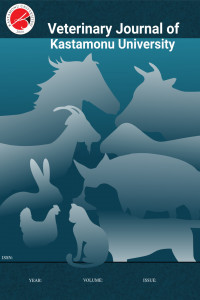Trichodectes pinguis (Phthiraptera: Ischnocera: Trichodectidae) and Haemaphysalis erinacei (Acari: Ixodida: Ixodidae) infestation on brown bears in Erzurum province
Trichodectes pinguis (Phthiraptera: Ischnocera: Trichodectidae) and Haemaphysalis erinacei (Acari: Ixodida: Ixodidae) infestation on brown bears in Erzurum province
Brown bears (Ursus arctos), which host various ectoparasites, are the largest carnivores in Türkiye. The present study represents tick and louse species found in brown bears in Erzurum. Four brown bears (3 dead, 1 alive) were brought to the parasitology laboratory and four brown bears were examined in terms of ectoparasite infestation. Transparency protocol was applied for louse samples, and species identification of all ectoparasites was performed under a stereo microscope. All lice and ticks were identified as Trichodectes pinguis and Haemaphysalis erinacei, respectively. There are limited studies concerning wildlife animal ectoparasites in Türkiye, especially on bears.
Keywords:
Brown bear, Haemaphysalis erinacei Trichodectes pinguis, Ursus arctos, wildlife,
___
- Ambarlı, H., Ertürk, A., & Soyumert, A. (2016). Current status, distribution, and conservation of brown bear (Ursidae) and wild canids (gray wolf, golden jackal, and red fox; Canidae) in Turkey. Turkish Journal of Zoology, 40, 944-956. https://doi.org/10.3906/zoo-1507-51
- Aydin, M.F., Balkaya, İ., Aktaş, M., & Dumanlı, N. (2011). Erzurum ilinde üç kırmızı tilkide (Vulpes vulpes) kene (Ixodoidea) ve pire (Siphonaptera) türleri. Türkiye Parazitoloji Dergisi, 35(2), 110-113. https://doi.org/10.5152/tpd.2011.27
- Dik, B., & Kılınç Ö.O. (2015). First case of Trichodectes pinguis (Phthiraptera: Ischnocera: Trichodectidae) on a Bear (Ursus arctos) in Turkey. Türkiye Parazitoloji Dergisi, 39, 313-315. https://doi.org/10.5152/tpd.2015.4040
- Durden, L.A. (2001). Lice (Phthiraptera). In: Samuel, W.M., Pybus, M.J., Kocan, A.A. (Ed.), Parasitic Diseases of Wild Mammals (pp. 3e17). Iowa State University Press.
- Esteruelas, N.F., Malmsten, J., Bröjer, C., Grandi, G., Lindström, A., Brown, P., Swenson, J.E., Evans, A.L. & Arnemo, J.M. (2016). Chewing lice Trichodectes pinguis pinguis in Scandinavian brown bears (Ursus arctos). International Journal for Parasitology: Parasites and Wildlife, 5, 134-138. https://doi.org/10.1016/j.ijppaw.2016.02.002
- Estrada-Peña, A., Mihalca, A.D., & Petney, T.N. (2017). Ticks of Europe and North Africa. Springer.
- Girişgin, A., Çimenlikaya, N., Bah, S., Aydın, A., & Girişgin, O. (2018). Türkiye’de Bazı Yabani Memelilerde Bulunan Dış Parazit Türlerinin İlk Kayıtları. Uludağ Üniversitesi Veteriner Fakültesi Dergisi, 37(2), 133-136.
- Hoogstraal, H. (1959). Biological observations on certain Turkish Haemaphysalis ticks (Ixodoidea-Ixodoidae). Journal of Parasitology, 45(2), 227-232. https://doi.org/10.2307/3286538
- Hopkins, G. H. E. (1954). Notes on some Mallophaga from bears. The Entomologist, 87, 140-146.
- Ikawa, K., Aoki, M., Ichikawa, M. & Itagaki, T. (2011). The first detection of Babesia species DNA from Japanese black bears (Ursus thibetanus japonicus) in Japan. Parasitology International, 60, 220-222. https://doi.org/10.1016/j.parint.2011.02.005
- Kolonin, G.V. (2007). Mammals as hosts of Ixodid ticks (Acarina, Ixodidae). Entomological Review, 87, 401-412. https://doi.org/10.1134/S0013873807040033
- Kubo, M., Uni, S., Agatsuma, T., Nagataki, M., Panciera, R. J., Tsubota, T., Nakamura, S., Sakai, H., Masegi, T. & Yanai, T. (2008). Hepatozoon ursi n. sp. (Apicomplexa: Hepatozoidae) in Japanese black bear (Ursus thibetanus japonicus). Parasitology International, 57, 287-294. https://doi.org/10.1016/j.parint.2008.01.002.
- Kusakisako, K., Niiyama, H., Asano, E., Haraguchi, A., Hakozaki, J., Nakayama, K., Nakamura, S., Shindo, J., Kudo, N., & Ikadai, H. (2022). Morphological and molecular phylogenetical identification of Tricodectes pinguis from Japanese black bears (Ursus thibetanus japonicus) in Aomori Prefecture, Japan. The Journal of Veterinary Medical Science, 84(7), 1015-1018. https://doi.org/10.1292/jvms.22-0107
- Morse, S.S. (1995). Factors in the emergence of infectious diseases. Emerging Infectious Diseases, 1, 7-15.
- Orkun, O., & Emir, H. (2020). Identification of tick-borne pathogens in ticks collected from wild animals in Turkey. Parasitology Research, 119, 3083-3091. https://doi.org/10.1007/s00436-020-06812-2
- Orkun, O., & Vatansever, Z. (2021). Rediscovery and first genetic description of some poorly known tick species: Haemaphysalis kopetdaghica Kerbabaev, 1962 and Dermacentor raskemensis Pomerantzev, 1946. Ticks and Tick-borne Diseases, 12(4), 101726. https://doi.org/10.1016/j.ttbdis.2021.101726
- Rakotonanahary, R. J., Harrison, A., Maina, A. N., Jiang, J., Richards, A. L., Rajerison, M., & Telfer, S. (2017). Molecular and serological evidence of flea-associated typhus group and spotted fever group rickettsial infections in Madagascar. Parasites & Vectors, 10, 125. https://doi.org/10.1186/s13071-017-2061-4
- Rogers, L.L., & Rogers, S.M. (1976). Parasites of Bears: A review. Bears: their biology and management, 411-430.
- Yokohata, Y., Fujita, O., Kamiya, M., Fujita, T., Kaneko, K. & Ohbayashi, M. (1990). Parasites from the Asiatic black bear (Ursus thibetanus) on Kyushu Island, Japan. Journal of Wildlife Diseases, 26, 137-138. https://doi.org/10.7589/0090-3558-26.1.137
- Başlangıç: 2022
- Yayıncı: Kastamonu Üniversitesi
Sayıdaki Diğer Makaleler
Operative approach to a case of perineal laceration in an Arabian mare
Öznur YILMAZ, Tarık ŞAFAK, Mehmet Akif KILINÇ, Burak Fatih YÜKSEL, Kerem ERCAN, Ali RİŞVANLI
Can thermal imaging technique be an effective method to assess pulp health in dogs?: a pilot study
Candemir ÖZCAN, Kürşad YİĞİTARSLAN
Rıdvan KİRMAN, Muzaffer AKYÜZ, Veysel DOĞAN
Evaluation of common liver masses and clinical and operative findings in a dog
The effects of modifications at milk and incubation conditions on the production of cow's kumiss
